From Tunics to Tweed: Tracing the Development of Traditional Irish Dress
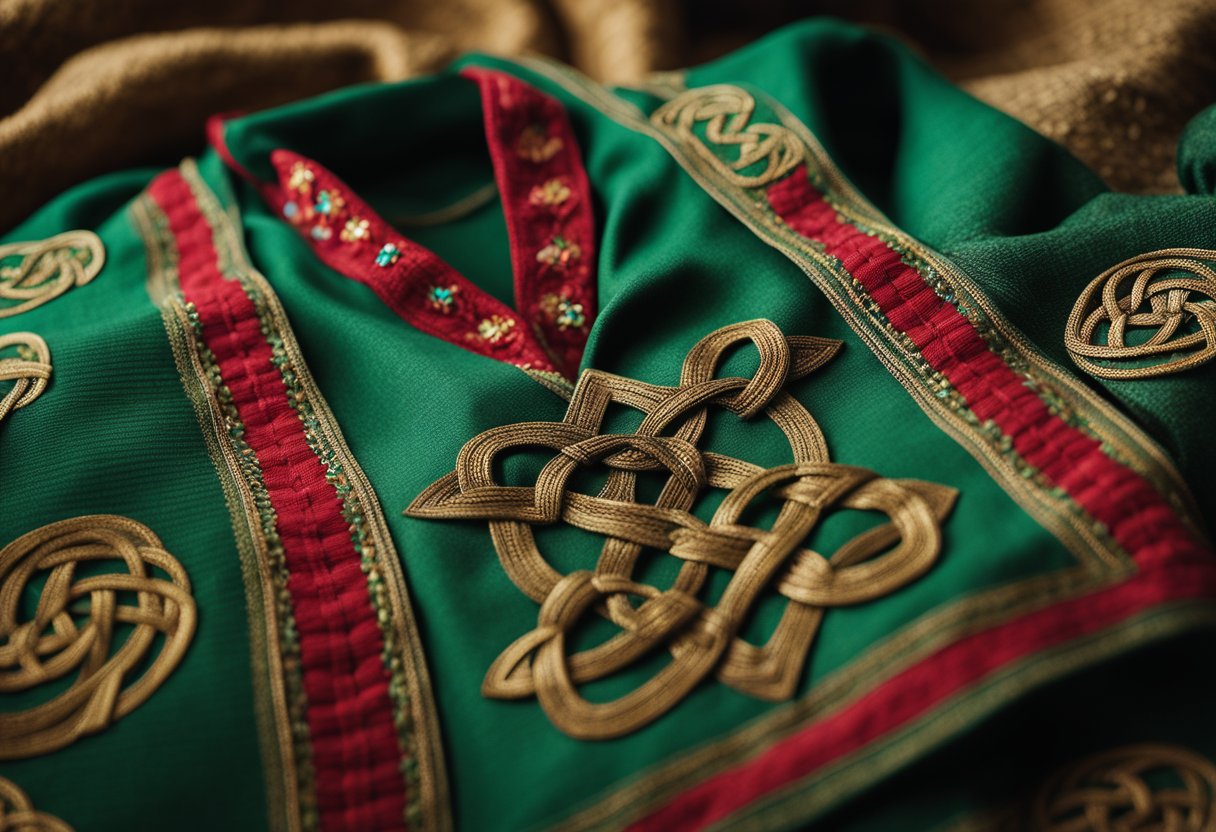
Updated On: April 24, 2024 by Eman Sameh
Traditional Irish dress has undergone a remarkable evolution, reflecting a deeper tapestry of Ireland’s history, culture, and craftsmanship. The earliest forms of Irish clothing were practical and designed for the unpredictable Irish weather. With time, these utilitarian items took on symbolic significance, becoming markers of identity and status. We observe how items like the léine—a traditional Irish tunic made of linen or wool—served as staples of Irish attire, adapting over the centuries in response to shifting social norms and influence from neighbouring traditions.
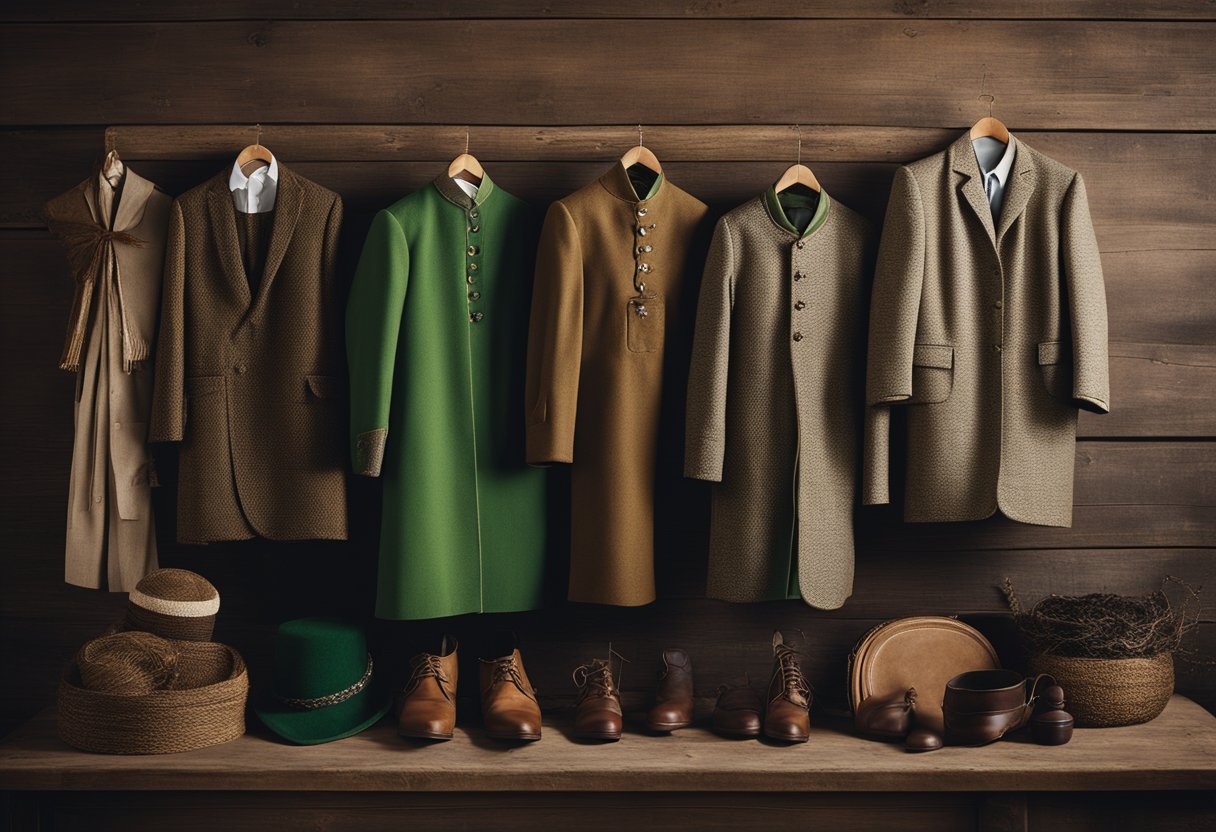
As we trace the history of traditional Irish dress, we witness a profound shift in the materials and methods of production. The craft of weaving, once a household activity, has blossomed into a celebrated aspect of Irish culture. The Irish landscape itself has influenced the textures and colours of Irish dress, from the green hues of the countryside to the rugged greys of the Atlantic coast. This evolution is exemplified in Irish tweed, a fabric that has become synonymous with Irish fashion and is revered for its durability, warmth, and distinctive style.
Origins of Traditional Irish Dress
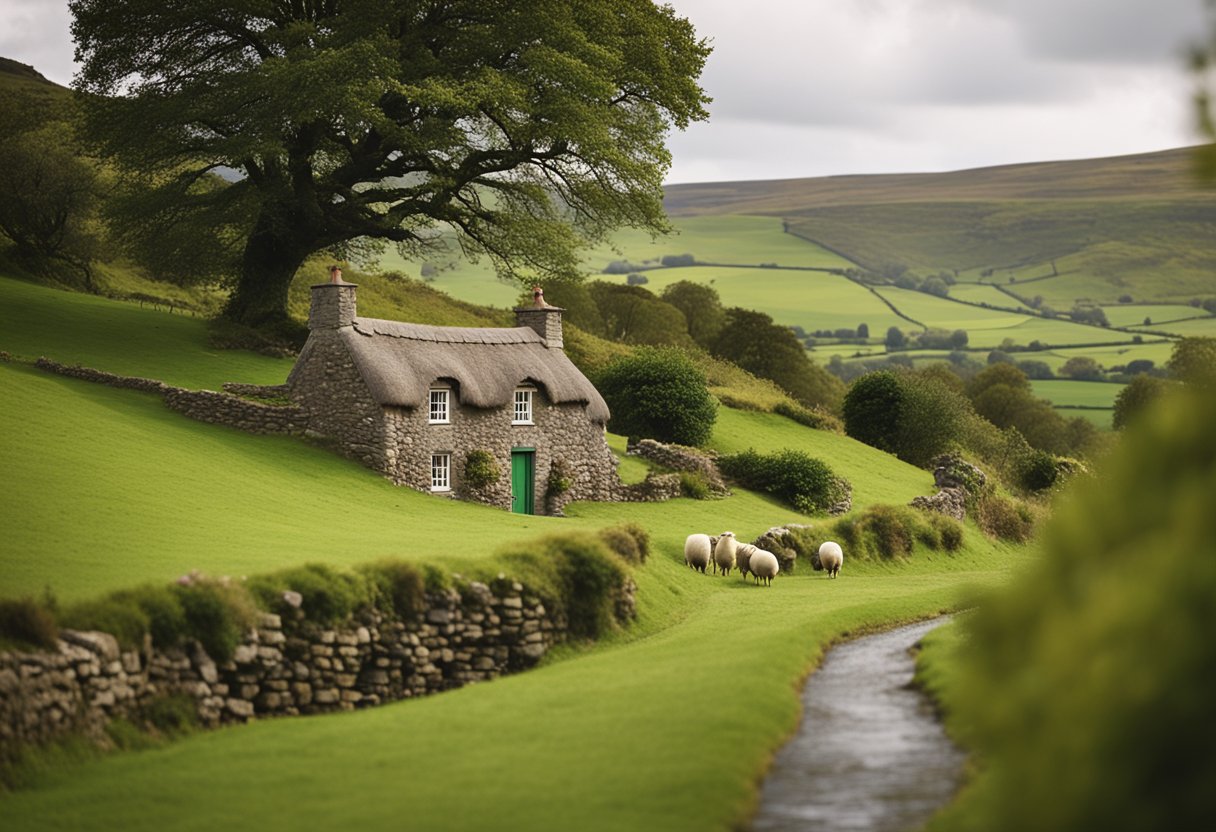
In examining the origins of Irish dress, one uncovers a history deeply interwoven with a Celtic influence and the island’s rich heritage.
Early Celtic Influences
Our exploration begins with the Celts, a group whose history and culture deeply impacted the fabric of Irish tradition. In ancient times, Celtic clothing consisted of simple and functional garments, often made from wool. These pieces were designed for the Irish climate and the daily activities of its people. Not only did the material provide warmth, but it also allowed for ease of movement in both work and warfare. The colours of these garments were primarily natural, with dyes made from local plants and minerals.
The Léine and its Significance
The léine, a garment akin to a tunic, held profound significance in traditional Irish dress. Made of linen or wool, it was typically dyed saffron and reached the knees or ankles. Men would wear it along with a brat, a kind of cloak, while the léine could extend to create a flowing dress for women. The léine’s form demonstrated both social status and regional styles, marking its importance in the Irish heritage. It was in this context that the foundational aspects of Irish clothing began to take shape, reflecting a society that valued practicality as well as societal identity.
Evolution of Fabrics
Tracing the lineage of traditional Irish dress reveals a distinct evolution of fabrics. This journey from basic woven textiles to robust fabrics symbolising Irish heritage shows the innovative spirit of the Irish people.
From Wool to Linen
Initially, wool was the cornerstone of Irish textiles, and it was appreciated for its warmth and availability. We used simple looms to weave this natural material, creating durable clothing suited to Ireland’s harsh climate. As trade and agriculture developed, linen, crafted from the flax plant, emerged as a sophisticated alternative. Valued for its lightweight and softer feel, linen became a staple for Irish clothing, especially in the warmer months.
Introduction of Tweed
Tweed represents another pivotal moment in our textile history, a material that encapsulates the essence of rural Ireland. Irish tweed, a woven fabric distinct for its water resistance and durability, became popular in the 19th century. This fabric’s unique weave patterns and earthy tones were not just practical but also began to carry a sense of Irish identity, earning recognition globally.
Tweed remains a testament to the innovative use of local materials to create textiles that are both functional and emblematic of Irish culture. Its resilience and style keep it an enduring choice in both fashion and practical attire, showcasing the seamless blend of tradition and relevance.
The Craft of Weaving
In our exploration of Irish dress evolution, the craft of weaving stands as a pivotal chapter, showcasing the skill and tradition embedded within Irish culture, particularly through the emblematic Donegal tweed.
Historical Weaving Techniques
Weaving, a practice dating back centuries, remains at the heart of Irish textiles. Historically, weavers employed looms that were simple yet effective for creating fabrics that were essential to everyday life. The wool, often sourced from local sheep, was spun and dyed using natural ingredients found within the land, resulting in textiles that were not only functional but also rich in character. This traditional craft was predominantly a cottage industry, with families passing down the knowledge and skills through generations, thereby preserving the heritage and importance of weaving in Irish society.
Donegal Tweed and its Artisans
Moving to the county of Donegal, we find a textile steeped in history and renowned for its quality: Donegal tweed. This fabric is characterised by its distinctive patterns, including the iconic herringbone, which is a V-shaped weaving pattern resembling the bones of the herringfish. The artisans of Donegal tweed have honed their craft to create tweed that is recognised for its durability and unique flecks of colour, often inspired by the natural beauty of the Donegal landscape. Donegal tweed has evolved from its utilitarian roots to become a fabric cherished in haute couture, showcasing the remarkable adaptability and enduring legacy of the weavers’ craft.
The Irish Brat and Mantles
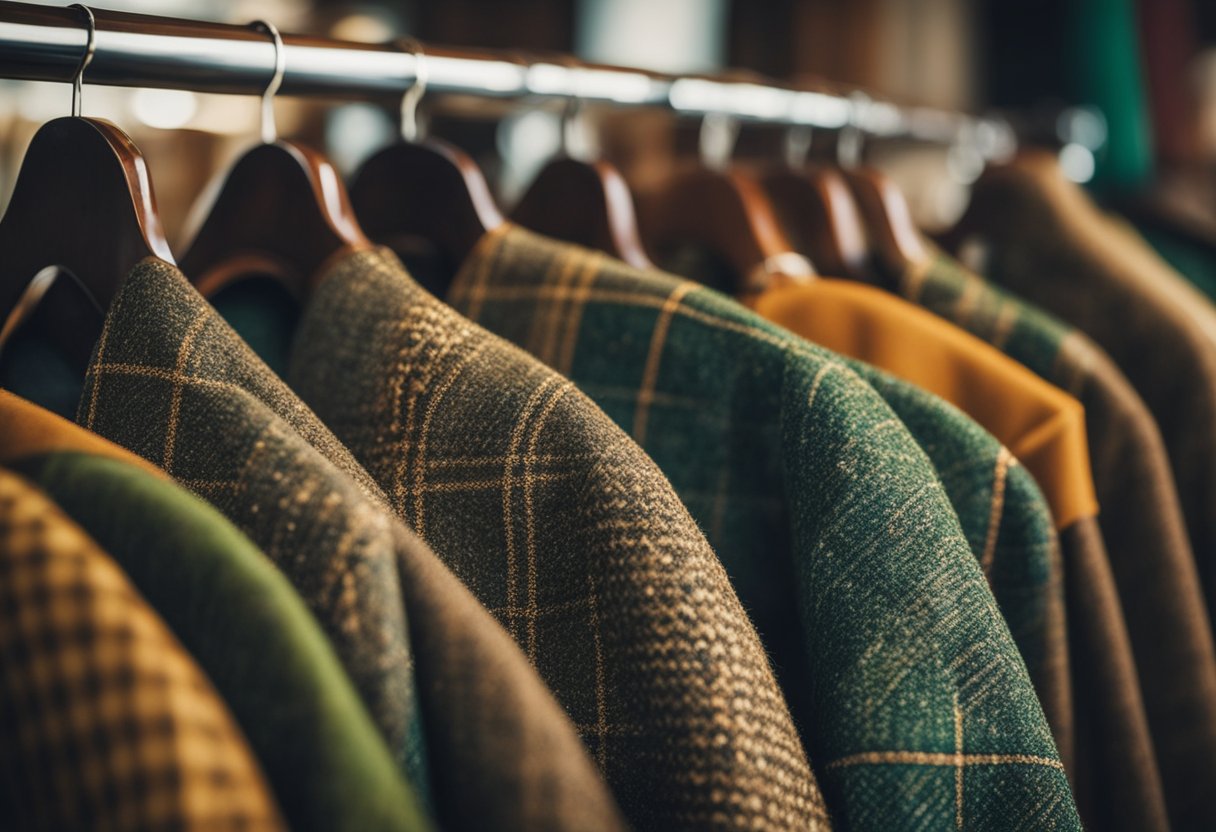
Before delving into the specific cultural and material facets of the Irish brat and mantles, it is pertinent to acknowledge these garments as epitomes of Ireland’s sartorial past. They are woven into the heritage and history of the nation, with their designs and colours mirroring the landscape of Ireland itself.
Cultural Significance
Often seen as symbols of Irish identity, the brat and mantles played significant roles throughout Ireland’s history. The brat, a type of cloak, served not only as a garment for warmth but also as a piece of cultural expression. The fashioning of these garments varied, indicating social status and regional origin. For example, certain dyes and patterns were used to signify different clans and districts, creating a rich visual tapestry of Ireland’s diverse communities.
Design and Material
In terms of design and material, brats and mantles were predominantly made from wool, a material readily available and suitable for the Irish climate. This ensured that they were durable and provided necessary protection against the elements. The texture and colour of these garments indicated the natural dyes that could be sourced from the landscape, such as berries, plants, and lichens, producing an array of hues from muted greens to rich browns.
The mantle, known for its heavy, woollen make-up, was often fastened at the shoulder and could come in various sizes and lengths, sometimes sweeping the floor, sometimes mid-length. The practical nature of these historical pieces exhibits the ingenuity of the Irish people in fashioning garments that withstood the test of time and the environment.
Irish Tweed in Fashion
We’ve come to appreciate the timeless elegance and undeniable quality of Irish tweed as a fabric integral to the world of fashion. It’s a material steeped in tradition yet continuously reimagined by contemporary designers and iconic Irish clothing brands.
Contemporary Use
Irish tweed has remarkably transitioned from a utilitarian cloth to a fashion statement. In today’s clothing industry, tweed is synonymous with luxury and durability, attracting modern designers to its rich texture and warmth. Contemporary fashion has embraced tweed, showcasing its versatility in everything from high-fashion runway pieces to ready-to-wear collections. Numerous Irish clothing brands have seamlessly integrated tweed into modern wardrobes, proving that heritage fabrics can evolve with the times.
Iconic Irish Clothing Brands
Prominent among those championing the fabric are some quintessentially Irish clothing brands. Donegal Tweed, originally handwoven in the northwest of Ireland, is featured prominently by brands such as Magee 1866, whose commitment to craftsmanship has kept the tradition alive. Another beloved name in the realm of Irish fashion is Avoca, which utilises the fabric’s unique qualities to craft items that resonate with contemporary style yet remain distinctly Irish in essence. These brands, among others, are at the forefront of positioning Irish tweed on the global fashion stage, blending time-honoured methods with innovative design.
Influence of the Irish Landscape
The verdant Irish landscape has profoundly shaped traditional Irish dress, from the patterns and colours inspired by nature to the materials sourced directly from the land.
Inspirations in Patterns and Colour
The breathtaking Irish landscape serves as a canvas for the country’s textile designs. We see an echo of the undulating hills and rugged coastal cliffs in the patterns woven into fabrics like tweed. The herringbone pattern, for instance, often used in Donegal tweed, mirrors the delicate bones of the herringfish, and this design is not just an artistic choice but an homage to our connection with the natural world. Equally, the traditional plaids found in Irish dress draw from the rich tapestry of greens, browns, and greys dominating Ireland’s countryside, reflecting an inherent respect for our heritage and surroundings.
Materials Sourced from Nature
Our traditions dictate a deep-seated reverence for natural materials, which is reflected in the selection of textiles. Wool has been a staple of Irish clothing for centuries, sheared from sheep grazing lush meadows. This material is not only abundantly available but also offers unparalleled warmth and water resistance, perfect for the Irish climate. Highly functional yet beautifully rustic, the fabrics and garments born from these resources are a testament to the indigenous knowledge passed down through generations, ensuring that each piece of clothing is a genuine expression of our Irish heritage.
By maintaining a close connection to the landscape, the customs surrounding Irish dress continue to evolve while honouring the ecosystem that shapes them.
Historical and Modern Weaving Mills
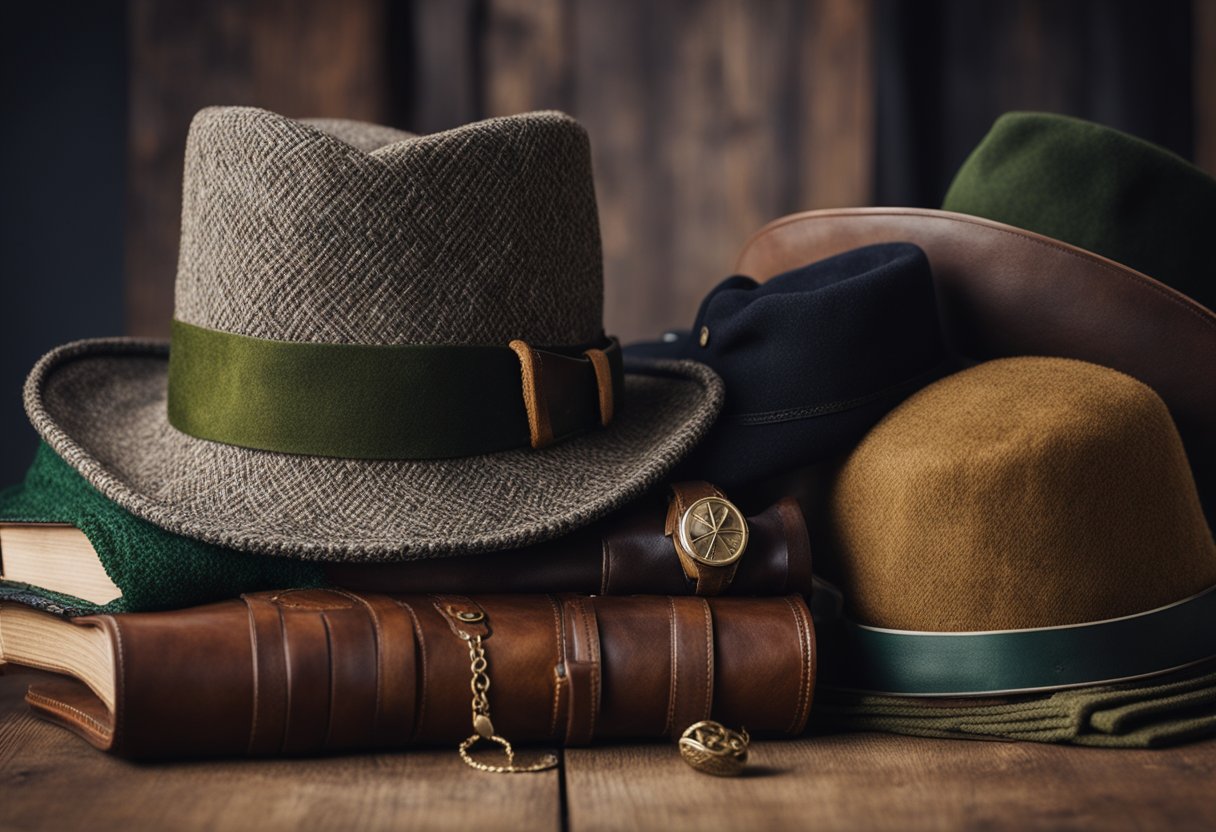
We will explore the enduring legacy of historical mills and the exciting advancements in modern textile innovation. Our focus will reflect traditions etched into our culture and the dynamic nature of the contemporary textile industry.
Mills and Their Heritage
Irish mills have a storied history, distinctly woven into the very fabric of our culture. The renowned Studio Donegal continues traditions that began in the 1930s, while the heritage of Magees of Donegal ties back to the 19th century. This legacy is not merely a tapestry of the past but a living continuation of craftsmanship that has become synonymous with Irish identity.
Modern Innovation in Textiles
Our industry today stands on the shoulders of these historical giants, pushing boundaries through modern techniques. Innovations enhance functionality, such as developing “smart” textiles that adapt to environmental changes. While maintaining reverence for our heritage, mills are now intertwining sustainability with tradition, future-proofing the very threads that bind us to Irish textiles.
The Story of Irish Linen
Irish linen‘s esteemed journey from plant to fabric encapsulates centuries of craftsmanship and global trade. This transformative process is deeply rooted in Ireland’s heritage and has left an indelible mark on the world’s textile industry.
From Flax to Yarn
Flax, the foundational plant for producing linen, is cultivated in Ireland’s damp, cool climate—conditions ideal for its growth. Once harvested, the flax fibres are separated in a process involving retting, scutching, and hackling until only the finest fibres remain. These fibres are then spun into yarn, a meticulous craft that can be traced back to the households of rural Ireland. Vawn Corrigan, an authority on Irish crafts through O’Brien Press, celebrates this tradition of transforming flax into the lustrous, strong yarn that weaves the narrative of Irish linen.
Linen in the Global Market
Irish linen gained prominence on the global stage for its exceptional quality. Throughout history, it was exported worldwide, from European courts to the shelves of far-reaching colonies. It became synonymous with luxury and durability, a testament to the skill of Irish weavers. The evolution of Irish linen from a homespun fabric to a high-value commodity in international trade underscores its resilience and adaptability, securing its place in the coveted halls of global markets.
Linen’s journey from local cottages to international stardom captures a legacy interlaced with unsurpassed craft—a fabric that proudly threads Ireland’s past with the future.
Traditional Clothing Accessories
In the realm of traditional Irish dress, accessories play vital roles, not only in terms of function but also in cultural expression. These accessories have become symbols of Irish craft through detailing like patterns and textures.
Aran Jumpers and their Patterns
Aran jumpers, originating from the Aran Islands off the west coast of Ireland, are emblematic of Irish knitwear. Known for their distinct cable patterns, each design holds significance, often inspired by the islanders’ daily lives, the harsh Atlantic climate, and Celtic art. Textures within these patterns—such as the cable, diamond, or basket—are rich in symbolism, representing various aspects of island life, including the fisherman’s ropes and nets. The texture of the wool used in creating Aran jumpers contributes to their durability and warmth, making them perfectly suited for the sometimes unforgiving Irish weather.
The Galway Shawl and Irish Caps
The Galway shawl, a cherished accessory among Irish women, particularly in bygone eras, showcases fine detail in its patterns. Predominantly worn in the West, this large shawl not only served as a comfort against the chill but also as a testament to the wearer’s style and familial traditions. The intricate designs on these shawls are often floral and exquisitely colourful, framed by a delicate fringe, highlighting the meticulous nature of Irish craft.
Meanwhile, Irish caps have become a staple in both rural and urban areas, woven into the fabric of our identity. These caps can be crafted from various materials, including the renowned tweed—a texture that is as enduring as it is evocative of the Irish landscape. The durability of these caps, along with their timeless design, ensure they remain a long-standing symbol in Irish apparel.
Legacy and Revival of Irish Dress
In our exploration of Irish dress, we find a remarkable journey from ancient garments to their modern incarnations. Central to this story are the efforts to preserve the legacy and the contemporary interpretations that celebrate the rich tapestry of Ireland’s sartorial history.
Historic Preservation
We acknowledge the definitive work of historians and craftspeople who have safeguarded Ireland’s heritage through meticulous documentation and preservation. Pieces once common in daily life, like the brat and leine, now play a pivotal role in showcasing Ireland’s cultural narrative. Museums and exhibitions across Ireland serve as custodians, displaying traditional Irish clothing and its significance within Irish society.
Modern Interpretations
In a contemporary context, revival efforts see Irish dress marrying tradition with modern design. Designers draw inspiration from the past to create modern interpretations of classic pieces such as the Aran sweater, reimagining them for today’s fashion landscape. This not only celebrates Irish culture but also supports local artisans and the economy. Meanwhile, elements like the Irish Tweed have been kept alive and relevant in fashion, as seen in the ongoing appeal of its distinctive weave and the importance of its place in Irish history and craftsmanship.
Colour and Texture in Irish Dress

In exploring traditional Irish dress, it’s essential to understand the depth of meaning in colour choices and the substantial role of texture that has evolved from plain neps to intricate yarns.
Significance of Colour Choices
The choice of colour in Irish dress has historically reflected social status and regional identity. While certain myths popularised green as Ireland’s national hue, the ancient Irish did not actually embrace a national colour. Instead, colours varied widely, often dependent on the dyes available from natural resources. Blues, blacks, browns, and greys were common, indicative of the vegetation and materials that were accessible for dyeing purposes.
Introducing Texture: Neps and Yarns
The texture of Irish clothing has been as significant as its colour. With a heritage deeply rooted in spinning and weaving, the craft has progressed from basic weaves to the complex patterns we see in traditional Irish tweed. Neps, small knots or clusters of fibres in the yarn, have contributed to the distinct texture of tweed, a fabric celebrated for its durability and warmth. The combination of different spinning techniques and weaving patterns has given rise to fabrics with unique tactile qualities that are beloved both in Ireland and internationally.
Frequently Asked Questions
In this section, we’ve gathered some common inquiries about the evolution of traditional Irish dress, highlighting key transitions from the distinct tunics of the past to the well-known tweed garments.
How has traditional Irish clothing evolved over the centuries?
Traditional Irish clothing has undergone significant changes since the ancient times of the Brehon Laws, which dictated the colours worn by different social classes. Over the centuries, garments adapted to social, political, and economic influences, eventually leading to the tweed we recognise today. One pivotal change was the transition from Brehon Law stipulations to more diverse sartorial expressions post-Norman invasion.
What are the distinguishing features of traditional Irish female attire?
Traditional Irish female attire was characterised by using the léine, a long tunic worn by both genders, layered with a brat—a type of cloak—which offered diverse colours and could indicate the wearer’s social status.
In what ways did traditional Irish male clothing differ through history?
Initially, the léine was a common element in both male and female clothing in Ireland. Throughout history, men’s attire evolved to include trews—tight trousers or leggings—and eventually transitioned to incorporating the iconic Irish tweed in various garments.
Can you describe the typical dress of Ireland during the 1800s?
During the 1800s, the typical Irish dress often consisted of simple yet practical attire due to economic hardships, with fabrics like linen and wool being very common. Male attire would see the inclusion of heavier woollen garments as protection against the Irish elements, laying the groundwork for the modern tweed fabric.
What are some key facts about the history of traditional Irish clothing?
Key facts about traditional Irish clothing history include the significance of the brat and léine in early Irish fashion, the socio-economic influences on fabric use, and the global recognition of Irish tweed as a staple in traditional Irish craftsmanship.
Where can one view images of historical Irish dress, such as the léine?
You can view images of historical Irish dress, such as the léine, or gain more in-depth historical context by exploring collections at museums or through digital archives. For detailed historical images and information, heritage sites and specific publications on Irish tweed also serve as valuable resources.






